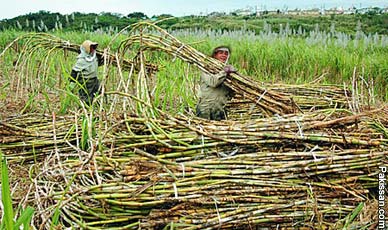Improving sugar recovery
By
Bilal Hassan
 THE
sugar content recovery of sugarcane cultivars grown in
the country varies from 7.5 to 8 per cent, far away from
international standards. Keeping this in view, the
Pakistan Sugar Mills Association has put forward a
proposal to develop local cane varieties with better
yield and sugar contents. The association has also
recommended importing varieties and technology from
Australia to bring cane yield at par with the
international levels. THE
sugar content recovery of sugarcane cultivars grown in
the country varies from 7.5 to 8 per cent, far away from
international standards. Keeping this in view, the
Pakistan Sugar Mills Association has put forward a
proposal to develop local cane varieties with better
yield and sugar contents. The association has also
recommended importing varieties and technology from
Australia to bring cane yield at par with the
international levels.
Importantly, the low yields of sugarcane variety SPF-238
has played havoc with sugarcane in most areas of Punjab,
except southern district of Rahim Yar Khan and Rajanpur.
So SPF-238 needs to be abandoned by growers of upper and
central Punjab. For that stringent efforts are required
to bring sugar industry out of crisis. On one hand, it
requires to trigger research system to come up with
varieties of high sugar contents and yield. At the same
time, management of sugarcane crop is essential to
enhance per acre yield.
At present, average production of sugarcane in Pakistan
is 22,000 kg per acre which is below the potential.
Agronomic factors like preparatory tillage, bed
preparation, planting techniques, planting time,
availability of irrigation water, application of
fertilisers, management of ratoon crop, harvesting time,
type of cultivars, plant protection measures
significantly affect cane yield per hectare. Yield of
sugarcane and sugar recovery in main sugarcane growing
countries of the world is given in the table for
comparison purpose.
It is appropriate to discuss various agronomic factors
contributing to low cane yield. Preparatory tillage
includes initial ploughing with a tractor-mounted
mouldboard plough which is considered essential and
should be done extensively. The use of a subsoiler after
every four or five years improves the soil considerably
by breaking the hardpan.
Sugarcane is a deep-rooted plant that requires a
well-worked and fully pulverised seedbed. Fine seedbed
can be prepared by ploughing with a furrow-turning
plough to a depth of about 20-25 cm particularly when
soil is clayey. Six to eight subsequent ploughings
followed by planking are enough to achieve a good
pulverised seedbed free of clods and weeds. Therefore,
use of seedbed preparatory implements is extensive. It
is important that seed bed preparation with adequate
moisture gives boost to tillering, essential to obtain
optimum number of plants per acre.
Timely sown crop yields more tillers because of soothing
effect of temperature. Day length is also an important
factor associated with vegetative and reproductive
growth..Two planting season of sugarcane crop are fall
and spring. Planting is done on both dry and wet seedbed
depending upon the soil condition, water availability,
planting time, etc. Double-cut sets are placed end to
end in furrows at a depth of 8-12 cm and covered with
5-6 cm soil. In the dry method, immediate irrigation is
essential, with subsequent irrigations at short
intervals.
Adequate and healthy seed ensures optimum plant
population, a factor significantly affecting cane
production. Optimum plant population depends on
appropriate seed rate and spacing but the growers often
ignored them, which is the key factor in lowering
sugarcane production. The seed rate and spacing between
rows differ with variety. Eight to nine tones of
stripped cane per hectare for thick varieties, and six
to seven tones for medium to thin varieties is
sufficient to produce a desired plant population of
about 0.15 million canes/ha.
Sugarcane is a perennial crop and water requirements on
an average varies from 120-160 centimetres for the
spring crop and 200-250 centimetres for the autumn crop
depending upon planting season, the fertility of the
soil, and the variety of cane. Autumn planting requires
a higher quantity of water than spring planting. During
the dry period, sufficient water should be applied at
relatively short intervals to avoid moisture stress.
Toward the end of the growing season, the length of the
intervals should be increased, with irrigation ceasing
25-30 days before harvest to induce normal maturity.
Total expenses on irrigation are, therefore, highest.
Soil fertility and productivity significantly affect
cane production. The nutrient requirements of sugarcane,
especially NPK, are higher than those of any other
commercial crop because of its high dry matter
production per unit area. Moreover, it is an exhaustive
crops like wheat, rice, maize etc. that uptake huge
amount of nutrients. It requires macro-as well as micro
nutrients. Each fertiliser elements plays its role in
the development and production of a normal cane crop.
Nitrogen is essential for plant growth; phosphorus for
developing roots, influencing the ripening process, and
purifying the juice; and potassium for promoting cell
activity and growth, increasing resistance to infection
and lodging, and improving sucrose content.
Sugarcane is heavily attacked by insects, pests and
diseases at various stages of growth. Even sugarcane can
be damaged from the first stage of growth by insects.
Termites, pink sugarcane mealy bug, sugarcane borer, top
borer, root borer, armyworm, Indian sugarcane
leafhopper, sugarcane white fly, white woolly aphid and
field cricket. Insects/pest cause damage to roots,
foliage, bud and shoot. Non-control of insects/pests,
therefore, leads to significant reduction in cane yield.
The extent of damage varies depending upon crop cultivar
and management practices.
Courtesy: The DAWN |
|
Pakissan.com;
|